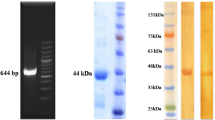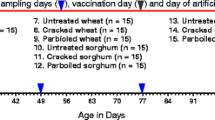Abstract
The present paper describes the field evaluation of local gametocyte vaccine and its comparative efficacy with commercial anticoccidial vaccine, LivaCox®, used in breeder and broiler flocks in Pakistan. Humoral immune response in vaccinated and control chickens was monitored by enzyme-linked immunosorbent assay. Results demonstrated significantly elevated antibody titres in vaccinated groups as compared to control groups conducted both in Laboratory and field experiments. Significantly (P < 0.01) higher antibody titres in local gametocyte-vaccinated group as compared to LivaCox®-vaccinated chickens were recorded. Splenic cell migration inhibition assay was used to detect the cell-mediated immune (CMI) response, and results were expressed in terms of per cent migration index. Lower per cent migration index in LivaCox®-vaccinated chickens indicated the higher CMI response, as compared to local gametocyte-vaccinated chickens, although the difference was statistically non-significant (P > 0.05). Results of the challenge studies in laboratory experiments revealed significantly higher (P < 0.05) oocyst count in LivaCox®-vaccinated group as compared to local gametocyte-vaccinated chickens.Maximum protection (75%) against mixed species of genus Eimeria was recorded in chickens vaccinated with gametocyte vaccines as compared to LivaCox®-vaccinated group. The mean body weight gains in chickens vaccinated with local gametocyte vaccine were significantly better (P < 0.05) than in chickens vaccinated with LivaCox® vaccine, both in laboratory and field experiments. Majority of the chickens (70–72%) in control group demonstrated severe lesions (3.0–4.0), while 20–26% chickens showed moderate lesions (2.0). On the other hand, local gametocyte- and LivaCox®-immunized chickens developed 78% and 85% mild to moderated lesions (1.0–2.0), respectively. Results of the present study provide a probable explanation for cross-protection induced by Eimeria tenella gametocyte vaccines against other species of genus Eimeria.




Similar content being viewed by others
References
Akhtar M, Hayat CS, Ashfaque M, Hussain I, Khan MA, Ayaz S (1999) Modified splenic cells migration inhibition test for the detection of cell mediated immunity against coccidiosis in chickens. Pak J Biol Sci 2:419–421
Akhtar M, Ayaz MM, Hayat CS, Ashfaque M, Hussain I (2002) Adaptation of Eimeria tenella sporozoites (local isolate) in the embryonated hen’s eggs. Pak Vet J 22:40–41
Allen PC, Fetterer RH (2002) Recent advances in biology and immunobiology of Eimeria species and in diagnosis and control of infection with these coccidian parasites of poultry. Clin Microbiol Rev 15:58–65
Annonymous (2002) LivaCoxÒ: live attenuated vaccines against coccidiosis in domestic poultry. Biopharm Research Institute of Biopharmacy and Veterinary Drugs. Czech Republic
Anwar MI (2008) Field trials of gametocytes vaccine (Local Isolate) and its comparative Efficacy with imported vaccine against coccidiosis in poultry. PhD thesis, University of Agriculture, Faisalabad, Pakistan
Ayaz MM (2003) Development of egg adapted vaccine (local isolate) against coccidiosis in poultry. Ph.D thesis, University of Agriculture, Faisalabad, Pakistan
Ayaz MM, Akhtar M, Hayat CS, Hussain I, Iqbal S (2002) Cellular immune response against coccidiosis in poultry through gametocytes. Proc. The 10th Intl. Congress of Parasitology Vancouver, Canada, pp 4–9
Ayaz MM, Akhtar M, Hayat S, Hussain I (2004) Control of coccidiosis in poultry through egg-adapted gametocytes. Proc. 1st Asean Congress on Parasitology and Tropical Medicine, Kuala lumpur, Malaysia, pp 23–25
Ayaz MM, Akhtar M, Hussain I, Muhammad F, Haq AU (2008) Immunoglobulin producing cells in chickens immunized with egg propagated Eimeria tenella gametocyte vaccines. Vet Med 53:210–216
Barrett JT (1988) Text book of immunology: an introduction to imunochemistry and immunobiology 5th edn. Mosby, Washington DC
Bedrink P, Kucera J (1988) Development of immunity against coccidiosis in broiler following administration of oocysts by different routes. Biologizae-a-chemizac-ivocissne vyroby Veternaria 24:507–514
Belli SI, Mai K, Skene CD, Gleeson MT, Witcomb DM, Katrib M, Finger A, Wallach G, Smith NC (2004) Characterization of antigenic and immunogenic properties of bacterially expressed, sexual stage antigens of coccidian parasite Eimeria maxima. Vaccine 22:4316–25
Belli SI, Smith NC, Ferguson DJ (2006) The coccidian oocyst: a tough nut to crack. Trends Parasitol 22:416–423
Bradford MM (1976) A rapid and sensitive method for the quantitation of microgram quantities of protein utilizing the principle of protein-dye binding. Anal Biochem 72:248
Calnek BW, Barnes HJ, Beard CW, McDougald LR, Saif YM (1997) Diseases of poultry, 10th edn. Mosby Woife, United States of America
Chapman HD (1999) Anticoccidial drugs and their effects upon the development of immunity to Eimeria infections in poultry. Avian Pathol 28:521–535
Conway DP, Mckenzie ME, Dayton AD (1990) Relationship of coccidial lesion scores and weight gain in infections of E. acervulina, E.maxima and E. tenella in broilers. Avian Pathol 19:489–496
Conway DP, Sasai KS, Gaffar M, Smothers CD (1993) Effects of different levels of Oocyst inocula of Eimeria acervulina, Eimeria tenella and E. maxima on plasma constituents, packed cell volume, lesion scores and performance in chickens. Avian Dis 37:118–123
Conway DP, Dayton AD, Mckenzie ME (1999) Comparative testing of anticoocidials in broiler chickens; the role of coccidial lesion scores. Poult Sci 78:529–535
Crouch CF, Andrews SJ, Ward RG, Francis MJ (2003) Protective efficacy of a live attenuated anticoccidial vaccine administered to 1-day-old chickens. Avian Pathol 32:297–304
Dalloul RA, Lillehoj HS (2005) Recent advances in immunomodulation and vaccination strategies against coccidiosis. Avian Dis 49:1–8
Danforth HD (1998) Use of live oocyst vaccines in the control of avian coccidiosis: experimental studies and field trials. Int J Parasitol 28:1099–1109
Fitz-Coy H, Edger SA (1992) Pathogenicity and control of E. mitis infection in broiler chickens. Avian Dis 36:44–48
Hafeez MA (2005) Immunogenic characterization of Eimeria tenella gametocyte antigen as vaccine against coccidiosis in poultry. PhD Thesis, University of Agriculture, Faisalabad, Pakistan
Hafeez MA, Akhtar M, Hussain I (2006) Protective effect of egg-propagated Eimeria tenella (local isolates) gametocytes as vaccine(s) against mixed species of coccidia in chickens. Parasitol Res 98:539–544
Johnson J, Reid WM (1970) Anticoccidial drugs: lesion scoring techniques in battery and floor pen experiments with chickens. Exp Parasitol 28:30–36
Kopko SH (1998) Responses of chickens to different immunizing strategies using a refractile body antigen of Eimeria tenella. PhD thesis,University of Gulph, Canada
Lee EH (1993) Immune variants in live coccidiosis vaccines. In: Barta JR, Fernando MA (eds) Proceedings of the VIth International Coccidiosis Conference. Univeristy of Guelph, Guelph, pp 118–121
Lillehoj HS (1998) Role of T lymphocytes and cytokines in coccidiosis. Int J Parasitol 28:1071–1081
Lillehoj HS, Lillehoj E (2000) Avian coccidiosis: a review of acquired intestinal immunity and vaccination strategies. Avian Dis 44:408–4025
Martin AG, Danforth HD, Brita JR, Fernando MA (1997) Analysis of immunological cross protection and sensitivities to anticoccidial drugs among five geographical and temporal strains of E. maxima. Int J Parasitol 5:527–533
McEvoy J (2001) Safe limits for veterinary drug residues: what do they mean? Northern Ireland Veterinary Today 37–40
Mello F, Paulo S, Alvarez R, Smith N (2006) A novel approach to coccidiosis control. Int Hatchery Prac 20:7–13
Mencher D, Pugatsch T, Wallach M (1989) Antigenic proteins of Eimeria maxima: cell free translation and detection with recovered chicken serum. Exp Parasitol 68:40–48
Michael A (2002) The practical use of a maternal vaccine against coccidiosis. World Poult 18:2–4
Morita C, Tzutsyn YY, Soekawa M (1973) Migration inhibition test of splenic ells of chickens infected with E. tenella. J Parasitol 59:199–200
Pugatsch T, Mencher D, Wallach M (1989) E. maxima: isolation of gametocytes and their immunogenicity in mice, rabbits and chickens. Exp Parasitol 68:127–134
Roitt I, Brostoff J, Male D (1998) Immunology, 4th edn. Mosby, London
Rose ME, Hesketh P (1976) Immunity to coccidiosis: stages of the life cycle of Eimeria maxima, which induce and are affected by the response of the host. Parasitol 73:25–37
Ryley JF, Meade R, Ifazalburst J, Robinson TE (1976) Methods in coccidiosis research: separation of oocyst from faeces. Parasitol 73:311–326
Shapiro D (2001) Coccidiosis control in replacement pullets. Int Hatch Pract 15:13–17
Shirley MW (1989) Development of a live attenuated vaccine against coccidiosis of poultry. Parasite Immunol 11:117–124
Shirley MW (1992) Research on avian coccidia: an update. Br Vet J 148:479–499
Shirley MW, Ivens A, Gruber A, Madeira AMBN, Wan KL, Dear PH, Tomley FM (2004) The Eimeria genome projects: a sequence of events. Trends Parasitol 20:199–201
Smith NC, Wallach M, Miller CM, Morgenstern R, Braun R, Eckert J (1994) Maternal transmission of immunity to Eimeria maxima: Enzyme linked immunosorbant assay analysis of protective antibodies induced by infection. Infect Immun 62:1348–1357
Speer CA, Hammond DM, Mahrt JL, Roberts WL (1973) Structure of the oocysts and sporocysts walls and excystation of sporozoites of Isospora canis. J Parasitol 59:35–40
Wallach MG (1997) The importance of transmission-blocking immunity in the control of infection by apicompexan parasites. Int J Parasitol 27:1159–1167
Wallach M (2002) The development of CoxAbicÒ a novel vaccine against coccidiosis. World Poult 18:2–4
Wallach M, Halabi A, Pillemer G, Sar-Shalom O, Mencher D, Gilad M, Bendheim U, Danforth HD, Augustine PC (1992) Maternal imununization with gametocyte antigens as a means of providing protective immunity against Eimeria maxima in chickens. Infect Immun 60:2036–2039
Wallach M, Smith NC, Braun R, Eckert J (1995) Potential control of chicken coccidiosis by maternal immunization. Parasitol Today 11:262–265
Wallach MG, Mencher D, Yarus S, Pillmemmer G, Halabi A, Pugatsch T (1989) Eimeria maxima: Identification of gametocyte antigens. Exp Parasitol 68:49–56
Williams RB (1999) A compartmentalized model for the estimation of the cost of coccidiosis to the world’s chicken production industry. Int J Parasitol 29:1209–1229
Acknowledgements
The funds for this project were sponsored by Pakistan Science Foundation, Islamabad, Pakistan (project no. P-PU/Bio/347).
Author information
Authors and Affiliations
Corresponding author
Rights and permissions
About this article
Cite this article
Anwar, M.I., Akhtar, M., Hussain, I. et al. Field evaluation of Eimeria tenella (local isolates) gametocytes vaccine and its comparative efficacy with imported live vaccine, LivaCox®. Parasitol Res 104, 135–143 (2008). https://doi.org/10.1007/s00436-008-1171-5
Received:
Accepted:
Published:
Issue Date:
DOI: https://doi.org/10.1007/s00436-008-1171-5




